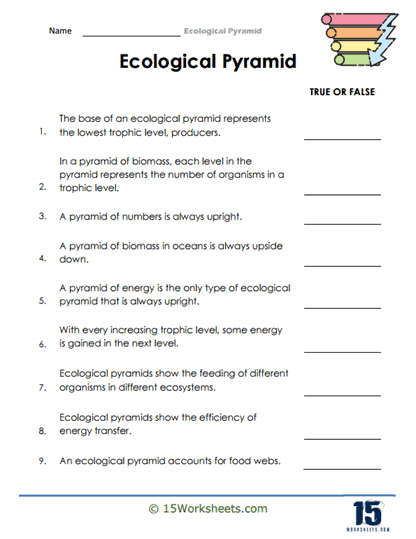True or False

Worksheet Description
This worksheet has you evaluate a series of statements and determine if they are true or false.
The worksheet is a true-or-false styled activity designed to test students’ comprehension of fundamental concepts associated with ecological pyramids. It covers various facets of the topic, ranging from the representation of trophic levels to the distinctions between different types of ecological pyramids. The questions delve into the nuances of energy transfer, biomass representation, and the functional differences between pyramids of numbers, energy, and biomass. With a total of nine statements, students are tasked with discerning the accuracy of each assertion, marking them as either true or false.
To tackle this worksheet effectively, students should carefully read each statement, recalling their knowledge of ecological pyramids. They should draw upon foundational concepts, such as the role of producers in ecosystems and the characteristics of different pyramid types. Critical thinking is crucial, as some statements may contain partially correct information, requiring discernment. Once they have considered each statement, students should mark them as “True” if they believe the statement is accurate or “False” if they deem it incorrect.
This worksheet aims to fortify students’ understanding of ecological pyramids and the principles underlying them. By assessing various statements about the topic, learners are encouraged to reflect upon and reinforce their grasp of the subject. The activity seeks to highlight misconceptions and correct them, ensuring that students have a comprehensive and accurate understanding of how ecological pyramids depict the flow of energy and the distribution of organisms across trophic levels. Ultimately, the goal is to deepen students’ appreciation for the complexity and beauty of ecological interactions and energy dynamics in nature.
How Do Ecological Pyramids Help Us?
Ecological pyramids are useful tools for understanding and studying the relationships between different organisms in an ecosystem. They help us in the following ways:
- Understanding energy flow: Ecological pyramids show the flow of energy through different trophic levels of an ecosystem, which helps us understand how energy is transferred from one organism to another.
- Studying food chains and webs: Ecological pyramids allow us to visualize the different trophic levels of a food chain or food web, which helps us understand how different organisms in an ecosystem are interconnected.
- Identifying ecosystem stability: The shape of an ecological pyramid can tell us a lot about the stability of an ecosystem. For example, if the pyramid of biomass is inverted (i.e., there is more biomass at the higher trophic levels than at the lower trophic levels), it may indicate an unstable ecosystem.
- Assessing human impact: Ecological pyramids can be used to assess the impact of human activities on an ecosystem. For example, if the pyramid of numbers is inverted (i.e., there are more predators than prey), it may indicate overhunting or overfishing in the ecosystem.
